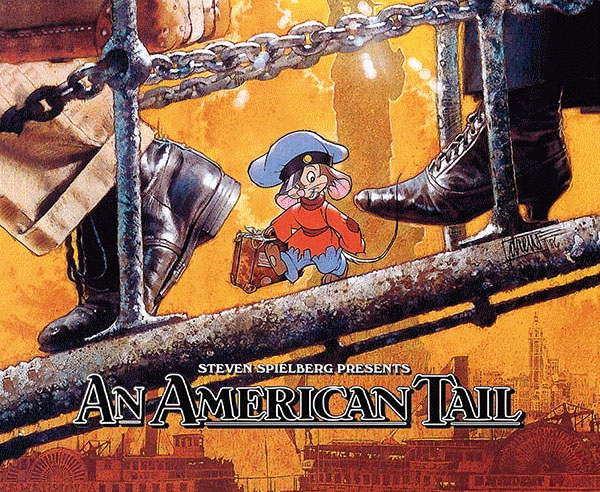A Fievel Revival: The 35th Anniversary of “An American Tail”


Through the years, in the vast array of movies that had gone up against Disney in the realm of animation, many had tried, but few had succeeded… until November 21, 1986.
It was on that day that An American Tail opened. It was a new, full-length animated feature, directed by Don Bluth and produced by Steven Spielberg, one of the most famous names in film and the maestro behind almost all of the significant movie blockbusters of the ’80s.

Don Bluth
This month marks the 35th anniversary of An American Tail. A perfect time to look back at the film that showed that competition in animation was most definitely a healthy thing.
“Steven provided an arena; he provided the money and plenty of ideas,” said Bluth in a 1997 interview when discussing An American Tail. Bluth is known for his much-publicized defection from Disney. He led a walkout of a group of animators during the production of 1981’s The Fox and the Hound.
Bluth and the artists who left intended to make animated features that they felt re-captured a spirit that was missing from Disney’s animated movies at the time. Their first was 1982’s The Secret of NIMH, which made a respectable, but disappointing, $13 million at the box office and received praise from critics.
The film also caught the attention of Steven Spielberg, who had an idea for an animated TV special that he wanted to expand into a theatrical feature. It was a story about the immigrant experience in New York City in 1885 and told of a young mouse named Fievel (also the name of Spielberg’s grandfather), who comes to America, from Russia, with his family.
Writers Tony Geiss and Judy Freudberg (who had written for Sesame Street) penned the screenplay and director Don Bluth and his producing partners Gary Goldman and John Pomeroy brought the story to life in animation.
 An American Tail takes place in the human world. Still, much like Disney’s The Rescuers (1977), the perspective is from Fievel and the other animals in the film, which opens in Russia, with Fievel Mouskewitz celebrating Hanukkah with his family.
An American Tail takes place in the human world. Still, much like Disney’s The Rescuers (1977), the perspective is from Fievel and the other animals in the film, which opens in Russia, with Fievel Mouskewitz celebrating Hanukkah with his family.
Their celebration is interrupted when the “the Catsacks” raid the village. After this, Papa Mouskewitz decides to bring his family to America. On their way to New York City, Fievel is separated from his family, meeting an eclectic melting pot of characters while trying to elude the villainous cats, throughout the film, before eventually being reunited with his family.
Young actor Phillip Glasser voiced Fievel, with a roster of well-known and character actors rounding out the cast, including Nehemiah Persoff as Papa Mousekewitz, Madeline Kahn as Gussie Mausheimer, a German-born mouse who rallies the other mice against the cats, Neil Ross as Honest John the Irish-mouse politician, Christopher Plummer, as Henri, a French pigeon, who befriends Fievel, John Finnegan as the villain, Warren T. Rat, Hal Smith as Moe, the rat who runs the local sweatshop, veteran voice actor Will Ryan, as Warren’s sidekick cockroach Digit and Dom DeLuise (who would become a Bluth voice mainstay), as Tiger, the large, friendly cat, who winds-up becoming Fievel’s best friend.

There was also the decision to make An American Tail a musical. Spielberg enlisted Cynthia Weil and Barry Mann to create songs for the film, with composer James Horner to craft the score.
One of the songs created for An American Tail, “Somewhere Out There,” went on to be a runaway Top 40 hit, receiving a tremendous amount of airtime on radio stations, as well as an Oscar nomination for Best Original Song.
It’s just one example of the marketing machine that was part of An American Tail’s release. In addition to the song, Fievel could be found on plush toys, books, and fast-food promotions, as the film was ubiquitous during the holiday season of 1986.
Bluth and his team of artists brought rich, full animation to An American Tail. One example is the scene with Fievel on the deck of a ship during a storm at sea. It is filled with impressive staging and effects, as the ocean seemingly comes alive. Excellent character design fills the film as well as lovely moments of personality animation, particularly in Tiger’s interactions with Fievel.
An American Tail did draw the ire of some film critics, who felt that the tone was bleak and depressing and that the immigrant experience was told through stereotypes. New York Newsday’s Joseph Gelmis wrote in his review at the time: “As for getting laughs by caricaturing ethnic types, it’s witless at best and, in at least one instance, offensive.”
Despite such reviews, An American Tail would gross $88 million at the worldwide box office. At the time, it was the highest-grossing animated feature in its initial release (beating Disney’s The Great Mouse Detective, released that summer).
The film’s success spawned the sequel An American Tail: Fievel Goes West in 1991 (celebrating its 30th anniversary this month), which didn’t fare as well at the box-office. However, Universal studio embraced the films, opening American Tail-themed playground sections in their theme parks and eventually producing a Saturday morning series.
The popularity of An American Tail was a “wake-up call” for many in an industry where Disney had dominated the box office for so long.
Three short years after the release of An American Tail, Disney’s The Little Mermaid would kick off an immensely successful decade for that studio. Other studios would then also throw their hats into the ring during an unprecedented renaissance period.
Many say that these “non-Disney” studios took a chance on animation at this time because of a mouse named Fievel, who cleared that path thirty-five years ago.
